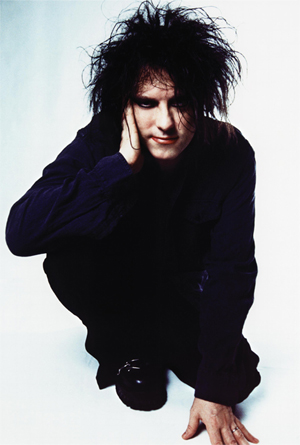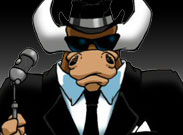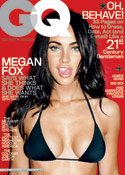
The Cure
Entertainers Home / Entertainment Channel
ALSO: Check out 's The Cure Deep Cuts playlist.
Is down the only way out for the Cure? Robert Smith has falsely claimed that the band was finished so many times now that actually calling it quits would be a shock to no one. Besides, how long can you seriously keep up the moping around? Apparently indefinitely, as the Cure continues to charm new generations of fans with its melancholy pop filled to the gills with themes of isolation and loneliness that strike a chord with any type of loner teenager. Of course, it does look (and sound) like it’s getting long in the tooth for Smith, but the Cure has enough certified classic hits to make that fact slightly unnoticeable to any newcomer.
It wasn’t always dour times, though. On their first album Three Imaginary Boys (Boys Don’t Cry in the U.S.), the Cure played as a trio, with Smith on guitar, Michael Dempsey on bass and Lol Tolhurst on drums. The album sounded like another fine and sprightly post-punk new wave group would be on the rise, with such tunes as “Boys Don’t Cry” and “Jumping Someone Else’s Train” released as singles. But all fun things must come to an end, and by the time Seventeen Seconds was issued, Dempsey was gone and Simon Gallup and Matthieu Hartley were added. Smith was unhappy with the debut, and so the new album took a turn toward the gloomy, yet still retained enough hooks from the first record to keep it buoyant.
All that was chucked, however, when Faith arrived. Signaling a new phase of lyrical depression and melancholic musical atmosphere, the Cure were positively turning Goth. This was compounded by the next release, Pornography, which many fans claim to be the first masterwork of the band’s, while everyone else considers it a real drag. Smith seemed to be at his bottom, though he must have found some relief through his songwriting exorcising whatever was dragging him down at the time. It did gain the band some more exposure, and soon Smith was moonlighting with Siouxsie and the Banshees. When he did rev up the Cure once again, it was through the appearance of two quite catchy new numbers, “The Walk” and the absolutely pop-infused “Let’s Go to Bed.”
Only a shred of this accessibility would make it onto the new album, however. “The Caterpillar” was a joyful bit of escape, but the rest of The Top was rather cryptic and experimental. It wasn’t dreary and overwrought like Pornography, but it was just…something different. Recorded mainly by Smith himself with help from drummer Andy Anderson and Porl Thompson on saxophone, the Cure was soon enough a real band on both stage and album. The resulting disc featuring Simon Gallup, Porl Thompson, and Boris Williams, along with Tolhurst was the excellent and accessible The Head on the Door, which broke all sorts of new ground and won fans with such great songs as “Inbetween Days” and “Close to Me.”
Everyone eventually gets the itch to do a double album, whether it’s necessary or not. The Cure decided to have a go at it with Kiss Me, Kiss Me, Kiss Me and scored an even bigger success than the prior album. Though the album is weighed down with filler here and there, it does contain the mega-huge “Just Like Heaven” along with “Hot, Hot, Hot” and “Why Can’t I Be You?” Each of these songs brought in a whole new set of Cureheads and massive success for the band, which left Robert Smith feeling decidedly bummed out yet again.
What came out of his misery this time was Disintegration. Hailed by many fans as the best thing the Cure ever created, the music and lyrical elements once again took a dark turn, resulting in more massive hits and radio play thanks to songs like “Pictures of You,” “Lovesong,” and “Fascination Street.” It was Goth for the mass markets and it struck yet another chord with all the new fans, prompting even more sales for the band and bigger concerts. Still, it wasn’t enough for the band not to kick Lol Tolhurst out, due to his personal problems with alcohol and not contributing much to the group anymore. And though he was credited on Disintegration, Tolhurst played and co-wrote nothing on the album.
After taking a bit of a break with the remix album Mixed Up, the Cure returned to their expected heights with Wish, which sported “Friday I’m In Love” and “High.” But by now the formula was wearing a bit thin, with the albums getting longer and longer and Smith’s moping becoming more shtick than serious. By the time Wild Mood Swings was issued, the popular musical landscape had changed and the band’s faithful didn’t care too much for the sound, which seemed like a bid for cheerier waters and a more experimental pop sound. Perhaps the semi-backlash worked, because Smith went right back in the studio with the band and returned with Bloodflowers, an overwrought, dismal piece of work that “completed” the trilogy that began with Pornography and continued with Disintegration. It was enough that led Smith to take the band out on a series of tours in which the Cure played those three albums in their entirety, back to back. Talk about a fun night out for the whole family.
Since then, the Cure have released their b-sides box set Join The Dots: B-Sides and Rarities, 1978-2001 (The Fiction Years) as well as a self-titled twelfth album in 2004. The band has been working on an upcoming release, which has been rumored to be another double-disc extravaganza, but each supposed release date for the project has come and gone with no word. Undoubtedly, whatever the Cure release, the fans will buy it, Smith will continue to wear his silly makeup, and there will be rumors of a breakup. So basically, same shit/different day – the way it’s always worked for the Cure.
 Tired of striking out? Check out these Dating Tips for all sorts of advice on how to finally get the girl! Also, we tell you all about some of the best online dating sites and how you can use them to hook up with more women!
Tired of striking out? Check out these Dating Tips for all sorts of advice on how to finally get the girl! Also, we tell you all about some of the best online dating sites and how you can use them to hook up with more women!
Quotable Cure:
Robert Smith on the band’s sound:
“We're not categorizable.
I suppose we were post-punk when we came out, but in
total it's impossible. I just play Cure music, whatever
that is.”
On writing gloomy lyrics:
“That's the difficulty of
writing songs that are a bit depressing. People think
you're like that all the time, but I don't think that.
I just usually write when I'm depressed.”
On doing those things rock stars tend to do at times:
“If
you feel like it, do it. Just say yes.”
The Cure on the Web:
The
Cure
Official
band website







